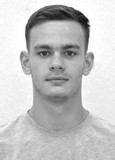Assessment of cyclists' pedaling techniques by patterns of muscle bioelectrical activity
Ключевые слова:
electromyography, bioelectrical muscle activity, cycling, pedaling.Аннотация
Objective of the study was to identify the features of the parameters of bioelectric activity of muscles that characterize the pedaling technique using the electromyography method.
Methods and structure of the study. A pilot study was organized with the participation of 2 athletes who had experience competing in major international cycling competitions. Each athlete performed a task during a standardized 30-second anaerobic test (Wingatetest) on a Cyclus 2 bicycle ergometer, recording the bioelectrical activity of the leading muscle groups of the legs.
Results and conclusions. Analysis of electromyograms made it possible to identify the individual characteristics of the implementation of the motor potential of each athlete according to parameters characterizing the contribution to the work of the leading muscle groups, the asymmetry of the manifestation of muscle activity on the left and right, as well as the ratio of muscle activity in the bench press and pull-up phases. The presented approach made it possible to clearly reflect the features of the pedaling technique of two athletes with a comparable level of preparedness and to form an objective idea of the mechanisms of involvement of the leading muscle groups in the work of the pedaling phases. A promising direction for further research is the use of electromyography as a means of biofeedback to optimize pedaling technique.
Библиографические ссылки
Lukashevich D.A. Metod elektromiografii v otsenke ratsionalnosti dvizheniy sportsmenov-grebtsov. Uchenyye zapiski BGUFK. 2019. No. 22. pp. 271-279.
Bishop C., Turner A., Read P. Effects of inter-limb asymmetries on physical and sports performance: a systematic review. Journal of Sports Sciences. 2018. No. 36 (10). pp. 1135-1144.
Gonzalez-Sanchez J. et al. Impact of rider position and pedaling cadence on power output and bilateral asymmetry in indoor cycling. The Journal of Sports Medicine and Physical Fitness. 2019. No. 59 (12). pp. 2009-2014.
Turpin N.A., Watier B. Cycling biomechanics and its relationship to performance. Applied Sciences. 2020. Vol. 10. Issue 12. pp. 4112-4117.

Дополнительные файлы
Опубликован
Как цитировать
Выпуск
Раздел
Лицензия
Copyright (c) 2024 Theory and Practice of Physical Culture

Это произведение доступно по лицензии Creative Commons «Attribution» («Атрибуция») 4.0 Всемирная.
